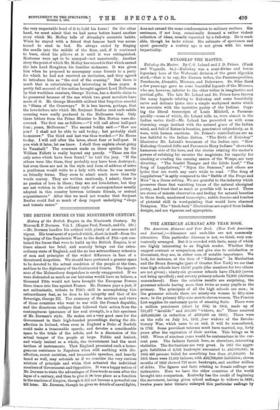KULOSKAP THE MASTER.
Kuloskap the Master. By C. G. Leland and J. D. Prince. (Funk and Wag,nalls. 8s.)—Kuloskap was a semi-divine and heroic legendary hero of the Wabanaki division of the great Algonkin stock,—that is to say, the Eastern tribes, the Passamaquoddies, Ponobscots, Abenakis, Micmacs, and Delawares. Dr. Silas Rand a few years ago gave us some beautiful legends of the Micmses, who are, however, inferior to the other tribes in imaginative and poetical gifts. The late Mr. Leland and Dr. Prince have thrown the many legends relating to Kuloskap and some beautifully naïve and delicate lyrics into a simple unrhymed metre which we associate with the narrative poetry of the Indians Copy- ing the literal transcripts of Louis Mitchell, a Passama- quoddy—some of which, Mr. Leland tells us, were almost in the Indian metre itself—Mr. Leland has presented us with some charming songs instinct with the natural grace of the Indian mind, and full of Nature's beauties, penetrated subjectively, as it were, with human emotions. Dr. Prince's contributions are no less faithful to the Indian diction. "The Birth of Kuloskap" illustrates Mr. Leland's treatment of the Indian epic. "How Kuloskap Granted Gifts and Favours to Many Indians" shows the humorous side of the hero, and the stories relating the master's powers of subduing his enemies the magicians, his capacity for smoking or evading the cunning snares of the Wimpe, are very diverting. "The Scarlet Tanager and the Little Leaf," "The Song of Lappilatwan," " Nipon the Summer," and others are lyrics that are worth any one's while to read. "The Song of Lappilatwan" is aptly compared to the "Battle of the Frogs and Mice" in a Norse setting. We are grateful to the industry which preserves these fad vanishing traces of the natural aboriginal poetry, and trust that as much as possible will be saved. There are stores of minute observation and feeling for natural beauties in these fresh, unadorned transcripts ; subtle fancies and touches of pictorial skill in word-painting that would have charmed Tennyson. The " birch-bark " illustrations are copied from Indian designs, and are vigorous and appropriate.


























































 Previous page
Previous page